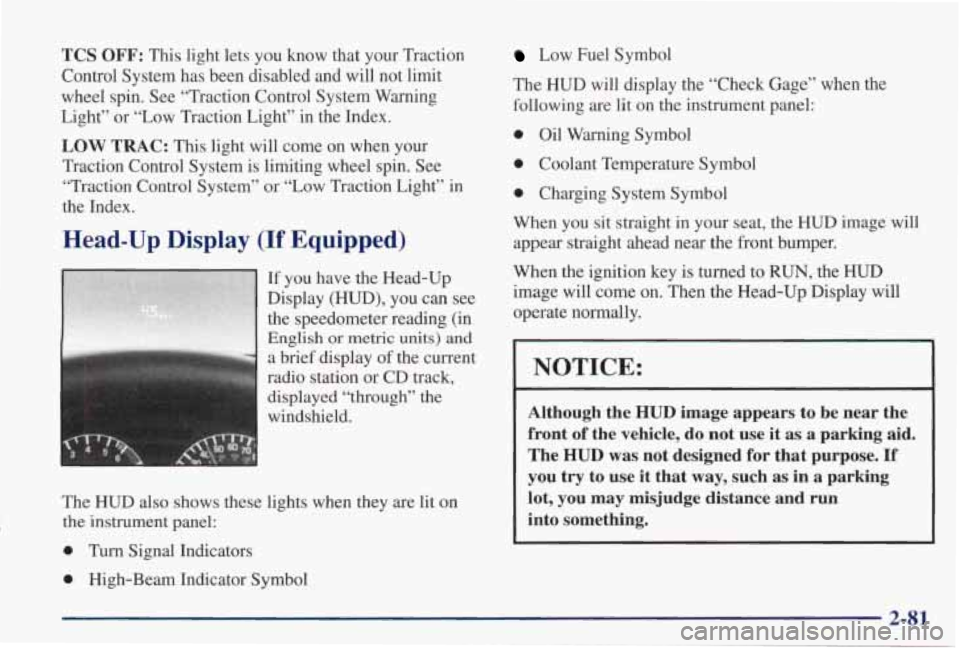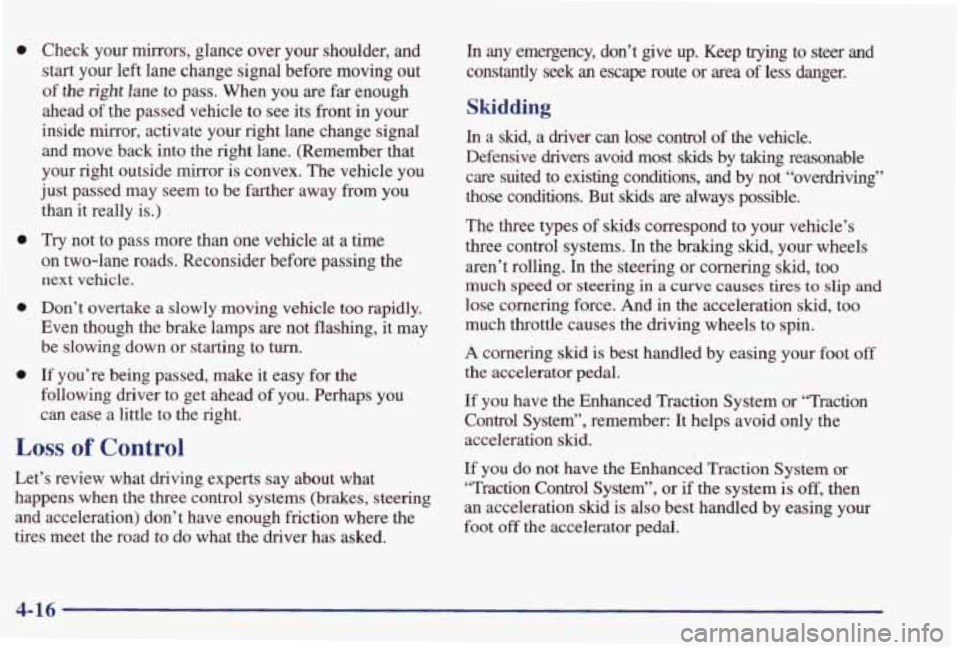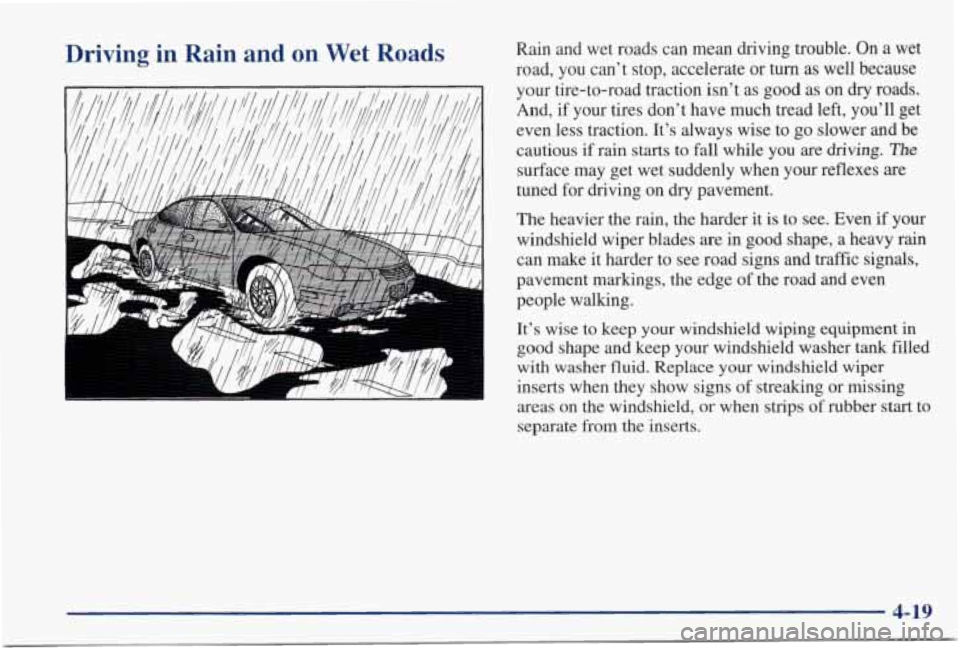1998 PONTIAC GRAND PRIX turn signal
[x] Cancel search: turn signalPage 6 of 402

Vehicle Symbols
These are some of the symbols you may find on your vehicle.
For example,
these symbols are used on an
original battery:
POSSIBLE A
CAUTION
INJURY
PROTECT EYES BY
SHIELDING
CAUSTIC
I
BURNS I
AVOID
SPARKS
OR
FLAMES
SPARK
OR ,\I/,
COULD
FLAME
EXPLODE BAllERY
These symbols are important for you and
your passengers
whenever your
vehicle is
driven:
n
UNLOCK Fol
FASTEN
SEAT
BELTS
op
AIR BAG p
These symbols
have to do with
your lamps:
SIGNALS 6
TURN
PARKING
p$ LAMPS
FOG LAMPS
$0
These symbols are
on some of
your controls:
WINDSHIELD
WIPER
WINDSHIELD DEFROSTER
VENTILATING
1
These symbols are used on
warning and
indicator lights:
COOLANT
TEMP
-
CHARGING I-1
BAllERY
SYSTEM
BRAKE
(0)
h
ENGINE OIL
PRESSURE
Here are some
other symbols
you may see:
FUSE
LIGHTER
m
HORN tcr
SPEAKER
b
FUEL e3
V
Page 81 of 402

To turn this feature on or off, see “Locks and Lighting
Choices” in the Index.
Last Door Closed Locking
The Last Door Closed Locking feature makes it more
convenient for you to use your power door locks
to lock
all the doors when leaving your vehicle. When any door is
open, the first time you attempt to lock
the doors using the
power door lock switch or remote remote keyless entry
transmitter will result
in three chimes to signal that Last
Door Closed Locking feature is being used.
All doors can
be opened for any reason for five seconds from the time
the last door has been closed. Five seconds
after the last
door
is closed, all doors will lock. You can lock the doors
immediately by using the power door lock switch or the
remote keyless
entry transmitter.
The Last Door Closed Locking feature will not occur
and doors will not be locked as a result of this feature
when the ignition switch is in RUN or ACCESSORY.
The Last Door Closed Locking feature is not enabled
from the factory.
To turn the Last Door Closed Locking feature on or off,
see “Locks and Lighting Choices” in the Index.
Automatic Door Locks
All of the doors will lock automatically when you move
your shift lever out of PARK
(P). All doors will unlock
automatically when the ignition is turned
off while the
shift lever is in PARK
(P). If you prefer to have your
doors unlocked automatically at
any time, see “Locks
and Lighting Choices” in the Index.
If someone needs to get in or out
of the vehicle after the
doors have been automatically locked, then place the
shift lever into PARK
(P). Unlock all doors by using the
power door lock switch or unlock just the door you want
by using the inside lever. If you have programmed your
automatic door locks (see “Locks and Lighting Choices’’\
in the Index) to unlock the doors when the shift lever is
shifted into PARK (P), then the doors will be
automatically unlocked
for you. The doors will
automatically lock when
you move your shift lever out
of PARK (P) with the ignition on.
If you don’t want the doors to unlock automatically
when you turn the ignition
off, see “Locks and Lighting
Choices” in the Index.
2-6
Page 109 of 402

Tilt Steering Wheel
A tilt steering wheel allows
you to adjust the steering
wheel before you drive. You
can
also raise it to the
highest level to give your
legs more room when you
exit and enter the vehicle.
To tilt the wheel, hold the steering wheel and pull the
lever. Move the steering wheel to a comfortable level,
then release the lever to lock the wheel
in place.
&rn SignaVMultifunction Lever
--
--I
The lever on the left side of the steering column
includes
your:
0 Turn Signal and Lane Change Indicator
0 Headlamp HighLow Beam
Windshield Wipers
Windshield Washer
Cruise Control (If Equipped)
2-34
Page 110 of 402

firn Signal and Lane Change Indicator
The turn signal has two upward (for right) and two
downward (for left) positions. These positions allow you
to signal a turn or a lane change.
To signal a turn, move the lever all the way up or
down. When the turn is finished, the lever will
return automatically.
An arrow
on the instrument
panel will flash in the
direction of the turn or
lane change.
7 I
A
To signal a lane change, just raise or lower the lever
until the arrow starts to flash. Hold it there until you
complete your lane change. The lever will return by
itself when you release it.
As you signal a turn or a lane change, if the arrow
flashes faster than normal,
a signal bulb may be burned
out and other drivers won’t see your turn signal. If
a bulb is burned out, replace it to help avoid an
accident.
If the arrows don’t go on at all when you
signal a turn, check for burned-out bulbs and then check
the fuse (see “Fuses and Circuit Breakers” in the Index).
A chime will sound if you leave your turn
signal on for
more than
3/4 mile (1.2 km).
Headlamp High/Low Beam Changer
To change your headlamps
from low
beam to high
beam, or high to low, pull the multifunction lever
all
the way toward you. Then
release it.
When the high beams are on, a light on the instrument
panel also will be on.
Flash-to-Pass Feature
When your headlamps are off, pull the lever toward you
to momentarily switch on the high beams (to signal
that
you are going to pass). When you release the lever, they
will turn
off.
2-35
Page 139 of 402

Warning Lights, Gages
and Indicators
This part describes the warning lights and gages that
may be on your vehicle. The pictures will help you
locate them.
Warning lights and gages can signal that something is
wrong before it becomes serious enough
to cause an
expensive repair or replacement. Paying attention to
your warning lights and gages could also save you or
others from injury.
Warning lights come on when there may be or is
a
problem with one of your vehicle’s functions. As you
will see in the details on the next few pages, some
warning lights come on briefly when you
start the
engine just to let you know they’re working. If you are
familiar with this section, you should not be alarmed when
this happens.
Gages can indicate when there may
be or is a problem
with one
of your vehicle’s functions. Often gages and
warning lights work together to let
you know when
there’s a problem with your vehicle. When one
of the warning lights comes on and stays on
when you are driving, or when one of the gages shows
there may be a problem, check the section that tells you
what to
do about it. Please follow this manual’s advice.
Waiting to
do repairs can be costly -- and even
dangerous.
So please get to know your warning lights
and gages. They’re a big help.
Your vehicle may
also have a driver information system
that works along with the warning lights and gages. See
“Driver Information System” in the Index.
Safety Belt Reminder Light
When the key is turned to RUN or START, a chime will
come on for about eight seconds to remind people to
fasten their safety belts, unless
the driver’s safety belt is
already buckled.
14
The safety belt light will
also come
on and stay on
for about
20 seconds, then
it will flash for about
55 seconds. If the driver’s
belt is already buckled,
neither
the chime nor the
light will come on.
2-64
Page 156 of 402

TCS OFF: This light lets you know that your Traction
Control System has been disabled and will not limit
wheel spin. See “Traction Control System Warning
Light” or “Low Traction Light” in the Index.
LOW TRAC: This light will come on when your
Traction Control System is limiting wheel spin. See “Traction Control System” or “Low Traction Light” in
the Index.
Head-Up Display (If Equipped)
If you have the Head-Up
Display (HUD), you can see
the speedometer reading (in
English or metric units) and
a brief display of the current
radio station or CD track,
displayed
“through” the
windshield.
The
HUD also shows these lights when they are lit on
the instrument panel:
0 Turn Signal Indicators
0 High-Beam Indicator Symbol
Low Fuel Symbol
The HUD will display the “Check Gage” when the
following are lit on the instrument panel:
0 Oil Warning Symbol
0 Coolant Temperature Symbol
0 Charging System Symbol
When you sit straight in your seat, the HUD image will appear straight ahead near the front bumper.
When the ignition key is turned to
RUN, the HUD
image
will come on. Then the Head-Up Display will
operate normally.
I NOTICE: I
Although the HUD image appears to be near the
front
of the vehicle, do not use it as a parking aid.
The
HUD was not designed for that purpose. If
you try to use it that way, such as in a parking
lot, you may misjudge distance and run
into something.
2-81
Page 209 of 402

0
0
0
0
Check your mirrors, glance over your shoulder, and
start your left lane change signal before moving out
of the right lane to pass. When you are far enough
ahead
of the passed vehicle to see its front in your
inside mirror, activate your right lane change signal and move back into the right lane. (Remember that
your right outside mirror
is convex. The vehicle you
just passed may seem to be farther away from you
than it really is.)
Try not to pass more than one vehicle at a time
on two-lane roads. Reconsider before passing the
next vehicle.
Don’t overtake a slowly moving vehicle too rapidly.
Even though the brake lamps are not flashing,
it may
be slowing down or starting to turn.
If you’re being passed, make it easy for the
following driver to get ahead of
you. Perhaps you
can ease a little to the right.
Loss of Control
Let’s review what driving experts say about what happens when the three control systems (brakes, steering
and acceleration) don’t have enough friction where the
tires meet the road to
do what the driver has asked.
In any emergency, don’t give up. Keep trying to steer and
constantly
seek an escape route or area of less danger.
Skidding
In a skid, a driver can lose control of the vehicle.
Defensive drivers avoid most skids
by taking reasonable
care suited to existing conditions, and
by not “overdriving”
those conditions. But skids are always possible.
The three types
of skids correspond to your vehicle’s
three control systems. In the braking skid, your wheels
aren’t rolling.
In the steering or cornering skid, too
much
speed or steering in a curve causes tires to slip and
lose cornering force. And in the acceleration skid, too
much throttle causes the driving wheels to spin.
A cornering skid is best handled by easing your foot off
the accelerator pedal.
If you have the Enhanced Traction System or ‘Traction
Control System”, remember: It helps avoid only the acceleration
skid.
If you do not have the Enhanced Traction System or
‘Traction Control System”, or
if the system is off, then
an acceleration skid is also best handled by easing your
foot
off the accelerator pedal.
4-16
Page 212 of 402

Driving in Rain and on Wet Roads Rain and wet roads can mean driving trouble. On a wet
road, you can't stop, accelerate
or turn as well because
your tire-to-road traction isn't as
good as on dry roads.
And, if your tires don't have much tread left,
you'll get
even less traction. It's always wise to
go slower and be
cautious if rain starts to fall while you are
driving. The
surface may get wet suddenly when your reflexes are
tuned for driving on
dry pavement.
The heavier the rain, the harder
it is to see. Even if your
windshield wiper blades are in good shape, a heavy rain
can make it harder to see road signs and traffic signals,
pavement markings, the edge of the road and even
people walking.
It's wise to keep your windshield wiping equipment
in
good shape and keep your windshield washer tank filled
with washer fluid. Replace your windshield wiper
inserts when they show signs of streaking or
missing
areas on the windshield, or when strips of rubber start to
separate from the inserts.
4-19